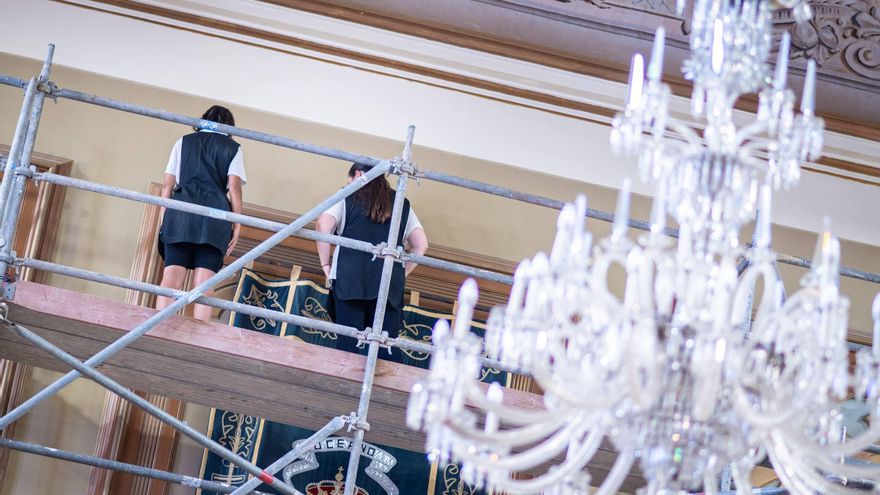
Canary Islands comprise of two provinces, each with its official coat of arms. In the House of Commons, there is a painting certifying this, but at some point during the 1st Legislature someone attempted to hide it, whether to bury the dispute or to exalt regional unity. Now, the House wants to recover it.
The plenary hall of the House of Commons of the Canary Islands has been presided over for over 40 years by two frescoes by Manuel González Méndez depicting scenes involving the two main figures of the conquest of the Archipelago namely Pedro de Vera (invader of Gran Canaria) and Alonso Fernández de Lugo (La Palma and Tenerife). In an unprecedented and surprising move in 2022, one of the Government’s parliamentary groups, Yes We Can Canary Islands, joined forces with CC, the main opposition party, to propose covering up these two paintings during plenary sessions. One of the reasons cited, aside from feeling “offended” by the two works that glorified the foundation of Santa Cruz de Tenerife by Fernández de Lugo and the handover of the Guanche princesses to the conqueror De Vera, was that a third canvas located between them and which ‘crowns’ the Presidency of the regional Chamber, was already hidden beneath layers of plaster and paint and covered by a tapestry bearing the official coat of arms of the Autonomous Community. This third canvas by González Méndez, which possibly represents the emblems of the province of Las Palmas and Santa Cruz de Tenerife, is the one that the Parliament aims to rescue and restore.
There is no documentary or photographic record of this third work, dated 1906, but oral tradition asserts its existence. For this reason, the regional Chamber decided to respond to a request made in 2019 by the Technical Unit of Historical Heritage of the Tenerife Island Council.
In December 2018, the Historical Heritage Service of the Tenerife Island Council requested to “verify the existence of a third painting that seems to be hidden behind a wooden panel” and on 18th March of the following year, the Technical Unit of Historical Heritage of the island corporation concluded, after meticulous sampling work, that “the recovery and restoration of the third canvas is necessary, returning a unitary discourse to the noble space of the hall, while recovering for the general public a work by one of the most prestigious Canarian artists of all time and undoubtedly one of the most internationally renowned.”
Concealed during the 1st Legislature
According to the Tenerife council, the oil on canvas attached to the wall measures 252 by 173 centimetres and “was covered with a tapestry in the 1980s, during the 1st Legislature” of the newly formed Autonomous Community.
The brushes of the two restorers from the Cúrcuma SL company in Tacoronte who have been perched on a scaffolding structure at the head of the plenary hall since 25th July will remain there for the month of August to remove the various superimposed layers of ochre paint covering the oil fresco. They have already managed to uncover parts of it, although it is still early to determine if complete restoration is possible.
The restoration work of this initial cleaning phase lasting a month has incurred a cost of 7,284 euros, as proposed by the technical architect advising the regional Chamber.
During the inactive month of August, the restorers will create digital images with sufficient resolution of each of the treated areas to showcase their conservation status, the restoration treatments carried out, and the results obtained upon completion. The materials used will be specific for Heritage restoration work, considering that the entire architectural structure housing the regional Chamber is a Cultural Interest Property (BIC) and, as acknowledged in a report by the Royal Academy of Fine Arts of San Miguel Arcángel, the paintings attached to the wall with concrete are “an inseparable part of the building”.
















